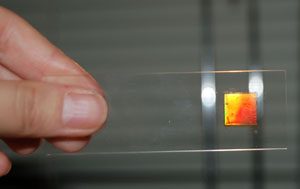Producing Nanoscale Patterns, In One Step
 Shu Yang’s latest discovery in the field of nanoscale polymer science may be her most significant yet.
Shu Yang’s latest discovery in the field of nanoscale polymer science may be her most significant yet.
It was also something of an accident.
Yang, an associate professor of materials science and engineering, initially set out with her students to study the intrinsic properties of a flexible polymer membrane called polydimethylsiloxane, or PDMS. The silicone material is a key ingredient in everything from contact lenses and window sealant to Silly Putty.
Surprisingly, when Yang exposed the membrane to a solvent, pores in the film deformed, naturally creating a diamond plate pattern.
By doing so, her lab may have stumbled upon an innovative method for designing the next generation of computer chips, more efficient and smaller devices for telecommunications, and potentially, new medical devices.
Working with Randall Kamien, a professor of physics in the School of Arts and Sciences, Yang laced the solvent with iron nanoparticles that orient themselves perfectly once the solvent dried. The researchers created a one-step, replicable method for the production of functional nanoscale patterns with adjustable features, sizes, and shapes using a single master “plate.”
The discovery, published in the journal Nano Letters, will allow scientists to easily manipulate structural details of the flexible membrane and create a variety of nanostructures. Using this patterning technique, Yang’s lab has fabricated a library of complex plates of gold nanostructures, which potentially will advance electronics, optics, micro-fluidic devices, sensors, and biochips.
The traditional fabrication process for nanoscale patterns requires a set of different master plates with various sizes and layouts, which contribute significantly to the production time and total cost of nanomanufacturing. In this new process, a master can be made for a fraction of the cost and can be reused many times. The features of these new patterns are up to 10 times sharper than the original membrane.
Says Yang of the surprise findings: “That’s the beauty of science. Sometimes it turns out unexpectedly but more exciting than you originally planned.”
Credit: Research at Penn, “Producing Nanoscale Patterns, In One Step,” Volume 8, page 14.
